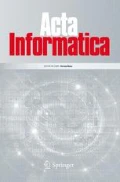Abstract
Watson–Crick (abbreviated as WK) finite automata are working on double stranded DNA molecule that is also called Watson–Crick tape. Subsequently, these automata have two reading heads, one for each strand. While in traditional WK automata both heads read the whole input in the same physical direction, in \(5'\rightarrow 3'\) WK automata the heads start from the two extremes (say \(5'\) end of the strands) and read the input in opposite direction. In sensing \(5'\rightarrow 3'\) WK automata the process on the input is finished when the heads meet. Since the heads of a WK automaton may read longer strings in a transition, in previous models a so-called sensing parameter took care for the proper meeting of the heads (not allowing to read the same positions of the input in the last step). Recently a new model is investigated, which works without the sensing parameter. In this paper, the deterministic counterpart is studied and is proven to accept the language class 2detLIN defined by the deterministic variant of the earlier version. However, using some of the restricted variants, e.g, all-final automata, the classes of the accepted languages are changed showing a finer hierarchy inside the class of linear context-free languages.
Graphical Abstract:













Similar content being viewed by others
References
Adleman, L.M.: Molecular computation of solutions to combinational problems. Science 226, 1021–1024 (1994)
Amar, V., Putzolu, G.R.: On a family of linear grammars. Inf. Control 7(3), 283–291 (1964)
Czeizler, E.: A short survey on Watson–Crick automata. Bull. EATCS 88, 104–119 (2006)
Fernau, F., Sempere, J.M.: Permutations and control sets for learning non-regular language families. In: ICGI 2000, LNCS/LNAI 1891, pp. 75–88 (2000)
Freund, R., Păun, G., Rozenberg, G. , Salomaa, A.: Watson–Crick finite automata. In: 3rd DIMACS Symposium on DNA Based Computers, pp. 297–328, Philadelphia (1997)
Hegedüs, L., Nagy, B., Egecioglu, Ö.: Stateless multicounter \(5^{\prime } \rightarrow 3^{\prime }\) Watson–Crick automata: the deterministic case. Nat. Comput. 11(3), 361–368 (2012)
Holzer, M., Kutrib, M., Otto, F.: Two-sided strictly locally testable languages. NCMA 2017, 135–150 (2017)
Hopcroft, J.E., Ullman, J.D.: Introduction to Automata Theory. Languages and Computation. Addison-Wesley Publishing Company, Reading (1979)
Kocman, R., Nagy, B., Krivka, Z., Meduna, A.: A jumping \(5^{\prime } \rightarrow 3^{\prime }\) Watson–Crick finite automata model. NCMA 2018, 117–132 (2018)
Kuske, D., Weigel, P.: The role of the complementarity relation in Watson–Crick automata and sticker systems. In: DLT 2004, LNCS 3340, pp. 272–283 (2004)
Kutrib, M., Otto, F.: Two-sided locally testable languages. NCMA 2018, 133–148 (2018)
Leupold, P., Nagy, B.: \(5^{\prime } \rightarrow 3^{\prime }\) Watson–Crick automata with several runs. Fundam. Inform. 104, 71–91 (2010)
Nagy, B.: On \(5^{\prime } \rightarrow 3^{\prime }\) sensing Watson–Crick finite automata. In: Preproceedings of DNA07, the 13th International Meeting on DNA Computing, pp. 327–336, Memphis, Tennessee, USA (2007)
Nagy, B.: On \(5^{\prime } \rightarrow 3^{\prime }\) sensing Watson–Crick finite automata. In: DNA 2007: Selected, Revised Papers, LNCS 4848, pp. 256–262 (2008)
Nagy, B.: On a hierarchy of \(5^{\prime } \rightarrow 3^{\prime }\) sensing WK finite automata languages. In: CiE 2009, Abstract Booklet, pp. 266–275 (2009)
Nagy, B.: \(5^{\prime } \rightarrow 3^{\prime }\) sensing Watson–Crick finite automata. In: Fung, G. (ed.) Sequence and Genome Analysis II—Methods and Applications, pp. 39–56. iConcept Press (2010)
Nagy, B.: A class of 2-head finite automata for linear languages. Triangle: Lang. Math. Approaches 8, 89–99 (2012)
Nagy, B.: On a hierarchy of \(5^{\prime } \rightarrow 3^{\prime }\) sensing Watson–Crick finite automata languages. J. Log. Comput. 23(4), 855–872 (2013)
Nagy, B.: A family of two-head pushdown automata. NCMA 2015, 177–191 (2015)
Nagy, B., Kovács, Z.: On simple \(5^{\prime } \rightarrow 3^{\prime }\) sensing Watson–Crick finite-state transducers. NCMA 2019, 155–170 (2019)
Nagy, B., Otto, F.: Two-head finite-state acceptors with translucent letters. In: SOFSEM 2019, LNCS 11376, pp. 406–418 (2019)
Nagy, B., Otto, F.: Linear automata with translucent letters and linear context-free trace languages. In: RAIRO—Theoretical Informatics and Applications, accepted for publication (2019)
Nagy, B., Parchami, Sh., Mir-Mohammad-Sadeghi, H.: A new sensing \(5^{\prime } \rightarrow 3^{\prime }\) Watson–Crick automata concept. In: AFL 2017, EPTCS 252, pp. 195–204 (2017)
Parchami, Sh., Nagy B.: Deterministic sensing \(5^{\prime }\rightarrow 3^{\prime }\) Watson–Crick automata without sensing parameter. In: UCNC 2018, LNCS 10867, pp. 173–187 (2018)
Păun, G., Rozenberg, G., Salomaa, A.: DNA Computing—New Computing Paradigms. Springer, Berlin (2002)
Rozenberg, G., Salomaa, A.: The Handbook of Formal Languages. Springer, Berlin (1997)
Sempere, J.M.: On the application of Watson–Crick finite automata for the resolution of bioinformatic problems. NCMA 2018, 29–30 (2018)
Sempere, J.M., García, P.: A characterization of even linear languages and its application to the learning problem. In: ICGI 1994, LNCS/LNAI 862, pp. 38–44 (1994)
Sempere, J.M., García, P.: Learning locally testable even linear languages from positive data. In: ICGI 2002, LNCS/LNAI 2484, pp. 225–236 (2002)
Acknowledgements
A part of the results of this paper were presented at UCNC 2018, France [24]. Comments of the reviewers are gratefully acknowledged.
Author information
Authors and Affiliations
Corresponding author
Additional information
Publisher's Note
Springer Nature remains neutral with regard to jurisdictional claims in published maps and institutional affiliations.
Rights and permissions
About this article
Cite this article
Nagy, B., Parchami, S. On deterministic sensing \(5'\rightarrow 3'\) Watson–Crick finite automata: a full hierarchy in 2detLIN. Acta Informatica 58, 153–175 (2021). https://doi.org/10.1007/s00236-019-00362-6
Received:
Accepted:
Published:
Issue Date:
DOI: https://doi.org/10.1007/s00236-019-00362-6




